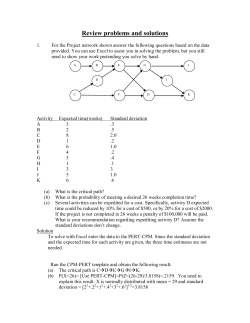
THE ABELL FOUNDATION Maryland Death Penalty Has Cost
THE ABELL FOUNDATION For Immediate Release March 6, 2008 Contact: Amanda Owens, 410-547-1300 Tom Waldron, 410-350-6637 Maryland Death Penalty Has Cost State Taxpayers More Than $186 Million New Urban Institute study finds each death sentence costs three times as much as a comparable non-death penalty case EDITORS NOTE: John Roman, senior research associate at the Urban Institute and author of the study, will give an overview of the study to the Senate Judicial Proceedings Committee today, March 6th, at the committee’s 1 p.m. hearing. BALTIMORE – Maryland’s death penalty has cost taxpayers at least $186 million, according to a new study prepared by the nonpartisan Urban Institute and commissioned by The Abell Foundation. This conservative cost assessment, which covers prosecutions for murders that occurred between 1978 and 1999, quantifies the costs of the death penalty over and above the costs of non-capital cases. The study is the most thorough state death penalty cost analysis conducted to date, documenting the extra costs that are required at every stage of a death penalty case. On average, a single death sentence costs Maryland $3 million, or $1.9 million more than a non-death penalty case, even including the cost of long-term incarceration. “The Abell Foundation has no position on the death penalty,” said Abell President Robert C. Embry. “But during this time of painful budget cuts and limited crime-fighting dollars, we hope state lawmakers will take a serious look at these numbers in assessing the death penalty’s value within the criminal justice system.” “This study for the first time calculates the cost of the death penalty here,” Embry said. “This prompts a question, are there more effective ways to spend taxpayers’ funds to promote public safety?” The study examined 162 murders between 1978 and 1999 that became death penalty prosecutions. Of these cases, a death sentence was returned in about a third, or 56 cases. The vast majority of these death sentences were ultimately reversed, leading to 1 five executions and leaving five people on death row. The study found that about 70 percent of the death penalty’s costs are incurred up front, at the trial level. Therefore, each of those reversals has saddled Maryland tax payers with both the high cost of the death penalty and the incarceration costs of a life without parole sentence, which is what most death sentenced inmates ultimately serve. For a copy of the study, go to www.abell.org and click Publications/Research to locate “The Cost of the Death Penalty in Maryland.” Among its key findings: • It costs the state about $3 million to seek and obtain a death penalty sentence. This is about $1.9 million more than the costs of a murder case in which no death penalty is sought, even with long-term incarceration taken into account. • About 70 percent of the added cost of a death notice case occurs during the trial phase. • Death sentences are more expensive at every stage of the process. They require a longer pre-trial period, a longer and more intensive voir dire (jury selection) process, longer trials, more time spent by more attorneys preparing cases, and an expensive penalty phase trial that is not required in non-death penalty cases. • Even prison costs are $316,000 higher for defendants sentenced to death. Most people sentenced to death ultimately have their sentences reversed, which means Marylanders are actually paying for both the expensive death penalty process and the cost of a life sentence. The type of incarceration on death row is also more expensive. The total $186 million figure does not include the costs of cases resulting from murders since 1999, the costs of death-eligible cases in which the defendant was acquitted or charges were dropped, nor cases where the death notice itself was ultimately dropped before trial. The figure also leaves out costs associated with many federal proceedings, as those costs are borne by Marylanders through their federal taxes rather than state taxes. Thus the total costs of the death penalty are likely higher. Relying on court records and interviews with public safety officials and lawyers involved in death penalty cases, the study calculates the extra costs generated when 2 prosecutors announce an intention to seek the death penalty, the additional costs borne during capital trials and sentencing, and the extra costs of maximum-security incarceration of death row inmates. To calculate the average costs of death penalty cases compared to non-death penalty murder cases, the researchers compiled data on 509 cases for which full information was available – out of a total of 1,136 death-eligible cases brought to court between 1978 and 1999. The researchers then weighted this sample of 509 cases to resemble the full set of 1,136 cases. Release of the study comes as the Maryland General Assembly is considering repealing the state’s death penalty. The report’s lead author is John Roman, a senior research associate at the Urban Institute and an expert in researching criminal justice issues. Roman can be reached through the Urban Institute: 202-833-7200. ### The Baltimore-based Abell Foundation supports projects that seek to find ways to break through the cycles of urban poverty and open the doors of opportunity to the disenfranchised. ____________________________ The Urban Institute in Washington, D.C., is a national, nonpartisan economic and social policy research organization. To promote sound social policy and public debate on national priorities, the Urban Institute gathers and analyzes data, conducts policy research, evaluates programs and services, and educates Americans on critical issues and trends. 3
© Copyright 2025





















